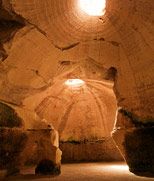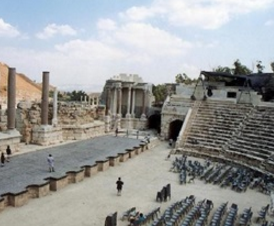Beit Shearim
December 21st 2014
Visitors to Israel are often amazed by the juxtapositions of ancient and modern that define their tour experiences. With findings dating back to the 2nd, 3rd and 4th centuries, Beit She’arim National Park definitely falls on the ancient side of the continuum. Located approximately 12 miles east of Haifa, Beit She’arim is best known for its range of intact burial sites. The most famous is the grave of Rabbi Judah HaNasi, the compiler of the Mishnah, a central Jewish reference text that is still studied today.
So impressive are the archeological finds at Beit She’arim that it appears on a tentative list for being recognized as a UNESCO World Heritage Site. Within the past five years, two new caves were opened to the public here, so that there are now more than 20 burial caves to explore.
 The Beit She’arim burial caves are richly decorated with reliefs and paintings rich with Jewish symbols, including the shofar, which is associated with the Rosh Hashana and Yom Kippur holidays; the lulav and etrog, which are still used on Sukkot; and the Ark of the Covenant and a menorah with seven branches, which are symbols of the Temples in Jerusalem. Other images that are not specifically Jewish – such as boats, animals and geometric patterns – can be found here as well. Images of Greek gods in human form are also pictured. Inscriptions appear most often in Greek, but there are some in Hebrew, Aramaic and in the obscure Aramaic dialect known as Palmyran.
The Beit She’arim burial caves are richly decorated with reliefs and paintings rich with Jewish symbols, including the shofar, which is associated with the Rosh Hashana and Yom Kippur holidays; the lulav and etrog, which are still used on Sukkot; and the Ark of the Covenant and a menorah with seven branches, which are symbols of the Temples in Jerusalem. Other images that are not specifically Jewish – such as boats, animals and geometric patterns – can be found here as well. Images of Greek gods in human form are also pictured. Inscriptions appear most often in Greek, but there are some in Hebrew, Aramaic and in the obscure Aramaic dialect known as Palmyran.
 In addition to touring the caves, the top of park’s hill has many ruins of the ancient city of Beit She’arim to explore. Look for the bronze statue of Alexander Zayid, who was among the founders of two Jewish defense organizations in the early 20th century, including Hashomer. Literally, Hashomer means “the guard.” It was an organization of Zionist pioneers that defended and protected the nascent Jewish agricultural settlements in pre-state Palestine. Also on the hill is the tomb of the Muslim Sheikh Abreik, distinctive because of its double dome.
In addition to touring the caves, the top of park’s hill has many ruins of the ancient city of Beit She’arim to explore. Look for the bronze statue of Alexander Zayid, who was among the founders of two Jewish defense organizations in the early 20th century, including Hashomer. Literally, Hashomer means “the guard.” It was an organization of Zionist pioneers that defended and protected the nascent Jewish agricultural settlements in pre-state Palestine. Also on the hill is the tomb of the Muslim Sheikh Abreik, distinctive because of its double dome.
In 1956, a construction crew at this site unearthed what was eventually identified as a nine-ton piece of glass. When a furnace for glassmaking stood here, ancient Beit She’arim must have been home to a remarkable glassmaking operation.












